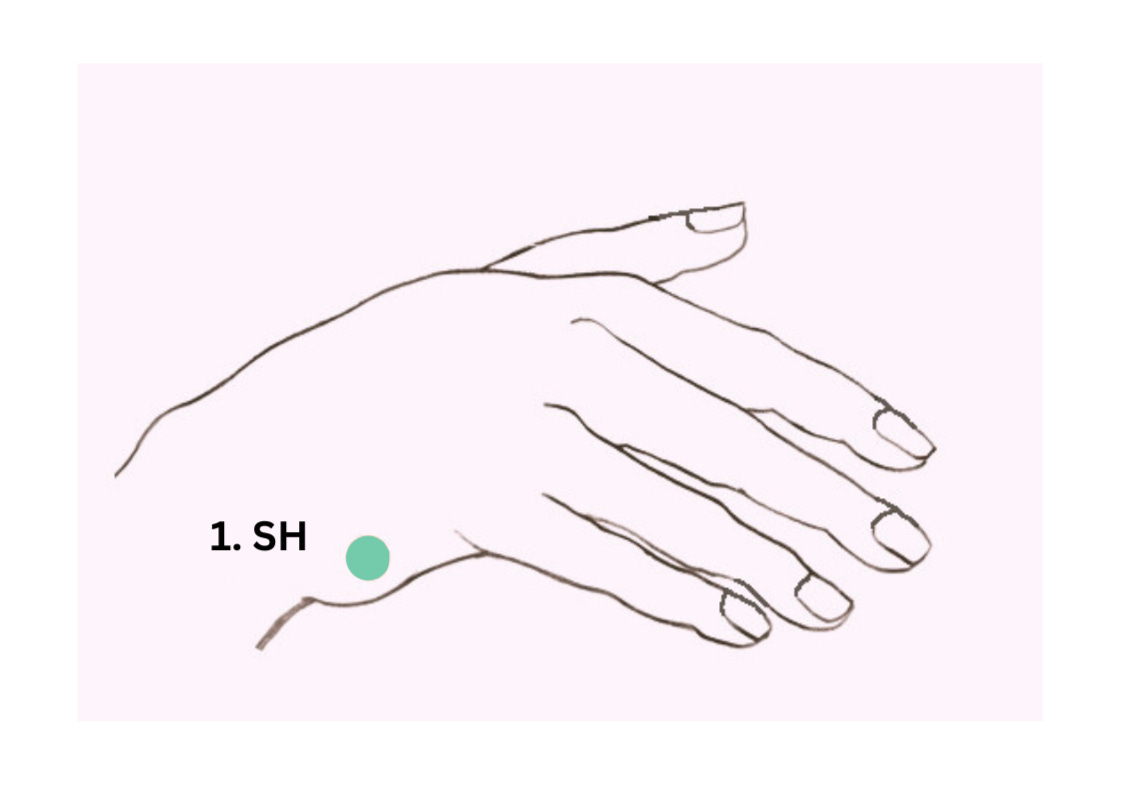This gentle practice helps me regulate pain, stress & overwhelm
Exploring the many benefits of EFT tapping
One of the practices I return to again and again, whether I’m managing pain or shifting stuck patterns, is something called Emotional Freedom Technique (EFT), also known as tapping.
Some proponents of EFT claim that it supports subconscious reprogramming and manifestation. And while I’m personally into energy work, I know that can feel a bit out there for some folks. Fortunately, EFT is a multifaceted tool with both research and clinical experience supporting its use for nervous system regulation.
When we’re able to return to regulation, we make better decisions, think more clearly, see situations with more nuance, and open our minds to new possibilities. It’s not inconceivable that a balanced nervous system and cortisol levels allow us to embrace our authentic selves and may start to attract more good stuff into our lives.
This topic was requested by a few folks in my network who’ve recently started practicing EFT and have felt the benefits. So, I thought I’d write a quick Tapping 101 to help you get started.
What is EFT?
EFTis rooted in the principles of Traditional Chinese Medicine (TCM) and works with the concept of meridian points on the body. The basic premise is that disruptions in the body’s energy system contribute to negative emotions and physical discomfort.
Tapping with your fingertips on specific meridian points while verbalizing phrases that acknowledge the issue is believed to help restore the body’s energetic balance.
While affirmations speak to the conscious mind, true transformation often requires engaging the subconscious and regulating the nervous system. We know that more sensory information travels from the body to the brain than in the opposite direction, which can explain why tapping on the body can amplify the verbal component.
Our minds and bodies are not separate entities, and tapping is a lovely resource that explores and supports this connection.
The General EFT Process
Identify the Issue: Concentrate on a specific challenge, such as physical pain, an emotion, a limiting belief, or a fear. It is also beneficial to ground and appreciate positive emotions when you’re in a regulated state, as this enhances our capacity for emotional resilience. I typically begin by addressing an issue or emotion and then after a few rounds of tapping, I gently guide myself to more constructive narratives.
Establish a Baseline: Start by measuring the intensity of the issue. You can think of a scale from 0 to 10, where 10 indicates it feels really intense or upsetting. Some practitioners might use a scale from -10 to +10 instead. If a numerical scale doesn't work for you, try assessing the intensity with images, colours, or bodily sensations. [I don’t always do this if I’m looking for some quick relief].
The Setup: While tapping the side of their hand (images below), you can repeat a setup statement three times. Here is an example set-up phrase:
Even though I have this [uncomfortable emotion/limiting belief/fear/feeling of pain], I deeply and completely love, honour and accept myself.
Sometimes it’s easier to start with a “formula”, but the setup phrase is flexible and can be adjusted to meet the requirements of the situation.
The Points: You tap on the following meridian points (5–7 times) in order, while saying a simple reminder phrase related to the problem. Tapping all the points is considered one round.
Side of Hand (SH): Small intestine meridian
Top of Head (TH): Governing vessel
Eyebrow (EB): Bladder meridian
Side of the Eye (SE): Gallbladder meridian
Under the Eye (UE): Stomach meridian
Under the Nose (UN): Governing vessel
Chin (CH): Central vessel
Collarbone (CB): Kidney meridian
Under the arm (UA): Spleen meridian
An example of a simple reminder phrase (points 2-9) is:
This [uncomfortable emotion/limiting belief/fear/feeling of pain].
You can change this phrase for each point or just keep it easy and use the same phrase each time.
*Keep in mind that people might tap in different orders or include more points on their fingers and hands. These extra points come from the original long version of EFT. This shorter version is easier to do on your own, but still offers real benefits. If any of the points don't feel good for you, it's totally fine to skip them.
Check the Intensity Again: After tapping a few rounds, take a moment to check the emotional intensity again and see if there’s been any change. Once you've done this, you can adjust your set up phrase to match how you’re feeling in the moment, or you can stick with the same words. Sometimes, as you tap, new feelings or situations related to the problem can come up. If that happens, you can tap a few more rounds on those new feelings or events to help neutralize them.
My EFT Experience
About six years ago, I tried Emotional Freedom Technique (EFT) for the first time. Back then, I was in almost constant physical pain and felt very overwhelmed and out of balance. I was in so much discomfort that I couldn't tap on myself, so my energy practitioner guided me through phrases while she tapped on herself.
This is referred to as “surrogate tapping.” It involves imagining yourself in someone else's situation and tapping on yourself for them. Just watching her tap made me feel more regulated, and I also noticed that my pain perception was lower after.
I later learned about a well-known phenomenon within EFT called "borrowed benefits." This occurs when an individual experiences emotional or physical relief simply by observing another person's EFT session. As humans, we are inherently interconnected, and tapping in group settings leverages borrowed benefits to harness shared energy and promote collective healing.
This effect is thought to be associated with observational learning and our shared emotional responses. Mirror neurons—brain cells that activate both when we perform an action and when we observe someone else doing the same, may allow us to experience similar emotional changes merely by watching someone else tap.
Although research in this neuroscience topic is still developing, this concept aligns with the common understanding that healing can extend outward in relational and communal contexts. A comparable phenomenon can be observed through social mirroring; for instance, the subconscious urge to yawn after seeing someone else yawn.
EFT has become one of my go-to tools for calming activation and sometimes, working through why I’m angry or anxious about something. I often feel a comfortable buzzy feeling in my body after I tap, like the energy is flowing.
Along with feeling better mentally, I usually experience some signs of stress release afterward, like laughing, yawning, crying, or feeling suddenly tired (usually after a lot of fight/flight energy).
I also love that EFT can be adjusted and done discreetly anytime, anywhere. It’s believed that each EFT tapping point has an emotional/energetic association, so just tapping on a certain point may also help with release.
For example, when I’m feeling really emotional (lot’s of mobilizing energy), either talking or thinking about the issue while tapping on my collarbone meridian points (#8) can be really soothing. This might be because the point is associated with safety and the fight-or-flight response.
How to Practice EFT
Individual Sessions: In 1:1 sessions with an EFT practitioner/coach, you’re gently guided through tapping while focusing on the emotional or physical issues you’d like to explore. Together, you can bring awareness to patterns, triggers, or sensations that are ready to shift. These sessions aren’t therapy, but they can offer supportive space for self-discovery and regulation.
Group Sessions: Participating in group EFT sessions (even informally) can be helpful, as they offer a supportive setting to connect and co-regulate. You can share experiences and tap on common concerns together, benefiting from the group's energy.
DIY: EFT can easily be used on your own. Once you learn the basics of tapping and how to create the setup phrases, you can apply EFT in your daily life to manage your emotions and symptoms as they come up.
Note: In sessions you don’t need to share intimate details of a situation for tapping to be effective. In fact, doing so might sometimes feel overwhelming or unhelpful.
Tapping works by focusing on the emotions and body responses connected to an issue, rather than analyzing or retelling it.
If talking about a specific topic feels dysregulating, that’s completely okay, you can still experience the benefits of tapping without going into the full story.
Trying out EFT — Tips and Helpful Tools
If you haven't had the opportunity to explore EFT or would like to take a deeper dive into the practice, here are some gentle suggestions for your next steps:
Hands-on Learning: There are many great online resources available, including videos and tutorials, that can help you navigate the EFT process. I personally found videos by Brad Yates, to be quite helpful when I first started.
Focus on Key Issues: It might be beneficial to focus on one specific issue or symptom at a time. For examples, for those with fibromyalgia, this could be pain in a particular area, sleep difficulties, or stress. Focusing on a specific area, such as back pain, can still have positive benefits on pain throughout the body.
Journal Beforehand: Consider jotting down your feelings before you begin tapping. This practice can help to identify subconscious words and phrases for your tapping routine and allow you to reflect on your progress. It’s easy to overlook how far we’ve come when we’re more regulated!
Setup Statements that Reflect Your Experience. For example, if you want to focus on back pain, you might try a statement like, “Even though I have ongoing pain in my lower back, I deeply and completely love, honour, and accept myself.”
Consistency: Regular tapping practice can be very helpful. Setting aside some time each day for EFT, can encourage you to naturally reach for the tool when you’re flaring or in periods of heightened stress.
Guided Tapping: Working with an EFT practitioner or coach might help you understand things better and make your tapping practice more tailored to you.
I incorporate tapping into coaching sessions, but I also offer dedicated 1:1 EFT sessions. You can book a session here, or visit my website for more details.
Have you tried EFT tapping before? I’d love to hear your experience!
Gentle hug,
Caitlin
~ On Medium: I Use EFT (Tapping) To Help Me Manage My Fibromyalgia Symptoms
✨If you’d like to explore practical tools to shift unhelpful patterns and build resilience in a way that honours your capacity, join us for Nervous System SOS: Spot the Signs, Build Resilience—a free 90-minute workshop on April 30th (12:30pm EST / 5:30pm UK). Register here or subscribe to The Nervous System Collective to get updates on future workshops.
✨Hi, I’m Caitlin (she/they)! Curious about nervous system-informed coaching? Book a free 30-minute discovery call to explore what working together might look like.






